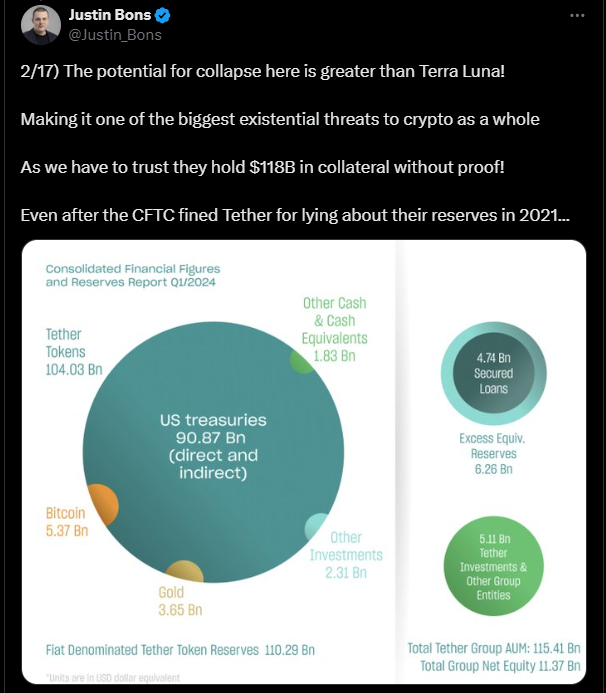Stablecoin giant Tether once again grabbed the headlines with a remarkable minting spree that injected over $5 billion into the market within a span of 72 hours.
This surge not only caught the attention of crypto enthusiasts but also raised eyebrows among financial circles, particularly given Tether’s historical significance in driving market liquidity.
At the epicenter of this development has been Howard Lutnick, CEO of American financial services giant Cantor Fitzgerald and a key figure in Donald Trump’s transition team.
In recent months, Lutnick has been vocal about defending Tether’s financial stability , a stance that coincided with Trump’s announcement of Lutnick as his nominee for secretary of commerce.
These developments came against a backdrop of ongoing investigations. The US Attorney’s Office for the Southern District of New York has been probing potential illicit activities associated with Tether, including concerns about terrorism financing.
Meanwhile, Cantor Fitzgerald has emerged as a critical banking partner for Tether at a time when many global banks have distanced themselves from the stablecoin issuer.
Tether’s impact on the market
Looking at data from blockchain analytics platform SpotOnChain, the timeline of events has revealed a strategic series of issuances from Tether. On Nov. 6, the firm minted $1 billion, coinciding with Bitcoin’s climb to a record high of $76,200.
They issued another $2 billion on Nov. 9 and 10, which helped push Bitcoin past the $80,000 mark. A final $2 billion injection brought the total five-day issuance to $5 billion.
The minting propelled Tether’s market cap to about $124 billion (which has increased to $132 billion at publication time ), solidifying its position as the most dominant stablecoin in the crypto ecosystem.
Recent: Pump.fun’s memecoin freak show may result in criminal charges: Expert
As a dollar-pegged cryptocurrency, Tether USDT$1.00 has continued to provide crucial liquidity to a number of centralized and decentralized exchanges, recently registering a 24-hour trading volume approaching $289 billion.
The expansion in supply seems to align with broader market optimism as historical increases in USDT circulation have correlated with gains in major cryptocurrencies like Bitcoin, with the asset recently approaching the historical $100,000 threshold , buoyed by market sentiment surrounding Trump’s forthcoming return to the presidency.
Lutnick’s double standards
Lutnick’s role in Tether’s operations has become increasingly complex and controversial over the last few months.
While publicly endorsing Tether’s reserves and claiming to have reviewed parts of the company’s balance sheet, he has notably failed to provide concrete public proof of these holdings.
Adding another layer of intrigue, Cantor Fitzgerald now owns a 5% stake in Tether , valued at around $600 million, according to a Wall Street Journal report. This stake may position the company to receive enhanced political support from the incoming Trump administration.
In recent interviews, Lutnick has indicated he is vetting candidates for government positions that might oversee Tether. He also said that if confirmed by the Senate, he plans to step down as Cantor Fitzgerald’s CEO — but might assume a different role.
This comes against the backdrop of Lutnick’s long-standing criticism of the Federal Reserve’s monetary policies, which makes his silence on Tether’s opaque practices particularly noteworthy.
Observers divided on Lutnick’s Tether link
Harshit Gangwar, head of marketing and investor relations for on-ramp services provider Transak, told Cointelegraph that Lutnick’s involvement with Tether underscores the strategic approach Tether seems to have taken in managing its reserves with reputable financial partners.
“While his roles may raise questions, they also highlight Tether’s commitment to aligning with traditional financial expertise to support its reserve assets. By focusing on transparency and providing clear disclosures, Tether can continue to build trust among institutional players, fostering confidence in the stability of USDT amid increasing regulatory scrutiny,” Gangwar said.
However, Abdul Rafay Gadit, CEO and co-founder of social investing platform Zignaly, told Cointelegraph that Lutnick’s repeated defense of Tether’s monetary positions has created a paradoxical situation for regulators seeking to maintain impartiality. He said:
“Enhanced transparency on the part of the issuer is essential not only for compliance with regulatory requirements but also for fostering and maintaining trust within the ecosystem.”
Tether’s backing woes
In September, Cyber Capital founder Justin Bons shared his concern about Tether potentially being a bigger scam than FTX:

In 2021, the United States Commodities and Futures Trading Commission (CFTC) leveled a significant blow against Tether, imposing a $41 million civil monetary penalty for systematic misrepresentations about USDt’s reserve backing.

The same year saw another pivotal legal development when Bitfinex agreed to an $18.5 million settlement with the New York Attorney General’s office. The settlement addressed serious allegations of financial misconduct, including false statements about Tether’s reserves and suspicious financial transfers between Bitfinex and iFinex designed to obscure substantial operational losses.
Even in the months following these investigations, Tether’s market influence continued to expand, with its market share escalating to control over 75% of the entire stablecoin ecosystem — a remarkable 20% increase over two years.
Others are less concerned, saying that the periodic attestation reports from auditing firm BDO Italia are sufficient.
Ivo Georgiev, CEO of crypto wallet provider Ambire, told Cointelegraph: “Tether has proven itself with time and provided multiple forms of proof of reserves, such as frequently updated reports from BDO Italia, which is a reputable third-party auditor.”
Additional scrutiny required?
In a surprising move on Sept. 8, Tether made a significant strategic investment, putting $100 million into Adecoagro , a major Latin American agricultural company, and securing a 9.8% stake in the enterprise. This investment marked the first substantial public insight into Tether’s governance and investment strategy.
Magazine: 1 in 6 new Base memecoins are scams, 91% have vulnerabilities
The disclosure immediately drew sharp criticism from industry observers. Bons quickly highlighted a critical governance concern on X:

Similarly, Sean Lee, co-founder of IDA Finance, echoed similar apprehensions about the company’s transparency. “Tether is structured as a business and their insistence on not providing the level of detailed transparency that ensures real trust from the community and institutional players is indeed concerning,” he said.

